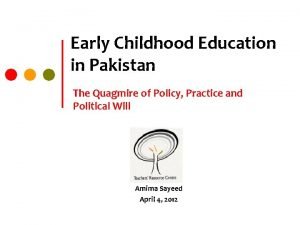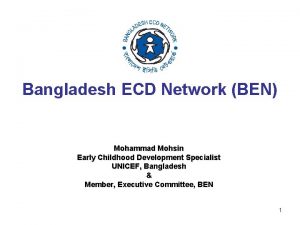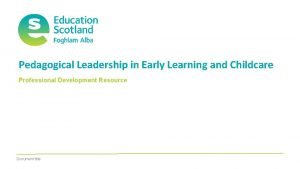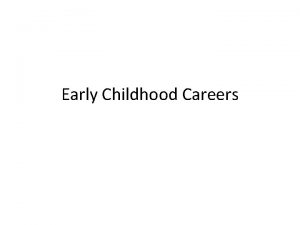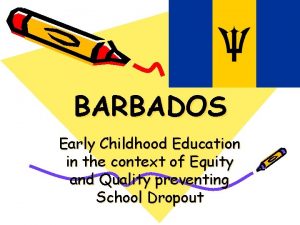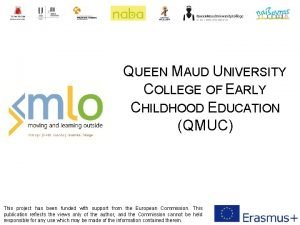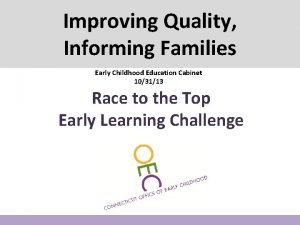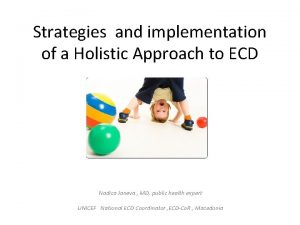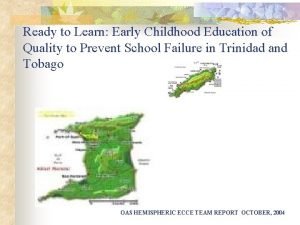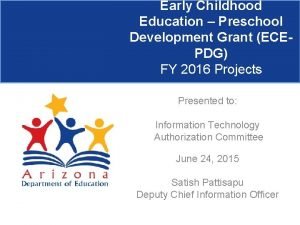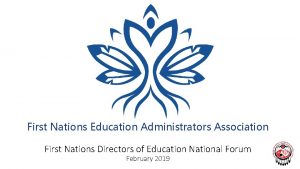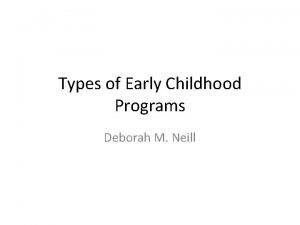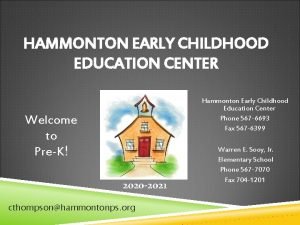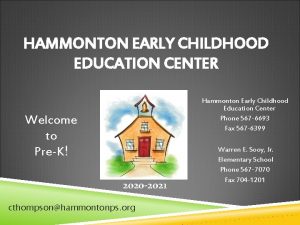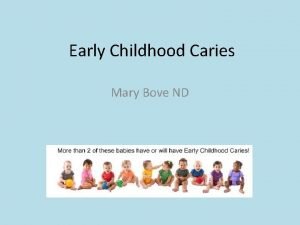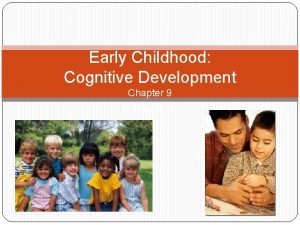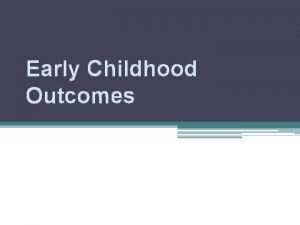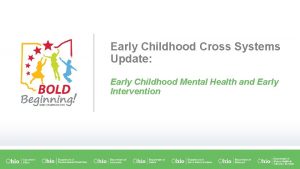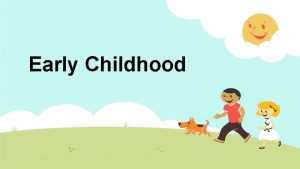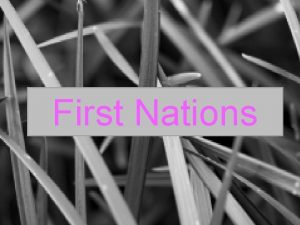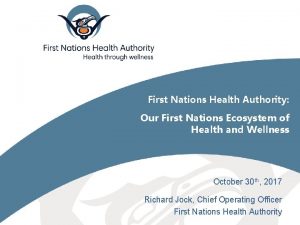Early Childhood Education in First Nations Communities The




















- Slides: 20

Early Childhood Education in First Nations Communities The Impact of UNDRIP Janice Ciavaglia

• “We believe that Aboriginal parents and Aboriginal communities must have the opportunity to implement their vision of education. Aboriginal children are entitled to learn and achieve in an environment that supports their development as whole individuals. They need to value their heritage and identity in planning for the future. Education programs, carefully designed and implemented with parental involvement, can prepare Aboriginal children to participate in two worlds with a choice of futures. Aboriginal people should expect equity of results from education in Canada. This will not happen if the education system continues unchanged. For significant change to occur, Aboriginal people must have the authority to organize their own education and to influence how their children are educated. ” Royal Commission on Aboriginal Peoples, Volume 3, Chapter 5, 1. 5 2

Vision • It is our vision that all First Nations infants, children, and their families have full access to safe, quality, communitycontrolled, culturally-based and language enriching comprehensive seamless Early Childhood Development (ECD) programs within an integrated First Nations ECD system, that supports families, ensures the holistic development of children, reduces disparities, improves developmental outcomes and helps all First Nations children to have the strongest possible start in life. 3

United Nations Declaration on the Rights of Indigenous Peoples (UNDRIP) • UNDRIP “represents, for all First Nations in the world, the results of more than 20 years of effort with the objective of specifying and enforcing their rights, including rights in education. ” Chief Picard, AFNQL 4

UNDRIP History Began work by the UN in 1985. The United Nations Declaration on the Rights of Indigenous Peoples (UNDRIP) was adopted by the General Assembly on Thursday, 13 September 2007, by a majority of 144 states in favour, 4 votes against (Australia, Canada, New Zealand the United States). In May 2016 Canada officially removed its objector status to UNDRIP, almost a decade after it was adopted by the General Assembly. 5

What is UNDRIP? • • • The goal of the Declaration is to encourage countries to work alongside indigenous peoples to solve global issues. Signifies the struggles of Indigenous People. Sets out the collective rights of Indigenous People (culture, education, identity, language, employment, health). Emphasizes the rights of indigenous peoples to maintain and strengthen their own institutions, cultures and traditions. Major emphasis that the indigenous peoples will be able to protect their cultural heritage and other aspects of their culture and tradition, which is extremely important in preserving their heritage. 6

• "No relationship is more important to me and to Canada than the one with Indigenous peoples. It is time for a renewed relationship with Indigenous peoples based on recognition of rights, respect, cooperation and partnership. " Justin Trudeau speaking to Assembly of First Nations, Dec 2015 7

IMPACT of UNDRIP • a monumental shift in the global will to protect the rights, culture, language, dignity and well-being of Indigenous people worldwide. 8

• “To support the work of reconciliation, and continue the necessary process of truth telling and healing, work with provinces and territories, and with First Nations, the Métis Nation, and Inuit, to implement recommendations of the Truth and Reconciliation Commission, starting with the implementation of the United Nations Declaration on the Rights of Indigenous Peoples. ” Letter from PM to Minister Bennett, 2016 9

• “Work with the Minister of Families, Children and Social Development to launch consultations with provinces and territories and Indigenous Peoples on a National Early Learning and Childcare Framework as a first step towards delivering affordable, highquality, flexible and fully inclusive child care” Letter from PM to Minister Bennett, 2016 10

Article 13 • “to revitalize, use, develop and transmit to future generations their histories, languages, oral languages, philosophies, writing system and , literatures, and retain their own names for communities, places and persons. ” 11

The NEED for Services • The First Nation population in Canada (53. 2% of the total Indigenous population) is young with a median age of 25 years, • Young Indigenous women are over 4 times more likely to be teenage mothers than non-Indigenous women and Indigenous children and more than twice as likely to live in a lone-parent family as compared to non-Indigenous Canadians. • 67% (of 430) First Nations communities reported having licensed child care within their communities. • 78% of the total proportion of children aged 0 to 5 years do not have access to licensed child care services in First Nations communities. 12

ECE opportunities are critical for providing a strong foundation on which to build healthy and confident First Nations individuals that succeed in life. 13

Program Support • Early childhood education initiatives are supported by First Nations’ inherent and treaty rights, the United Nations Declaration on the Rights of Indigenous Peoples, and the Convention on the Rights of the Child. 14

Adequate support for the delivery of quality ECE programs in First Nations communities, require, at minimum, the following components: • Program design and delivery to train early childhood professionals. • Development of standards and regulations. • Funding for students to obtain early childhood credentials. • Infrastructure, operation and maintenance for the provision of licensed services in all First Nations communities. 15

• Support for curriculum development in which language and culture is embedded. • Support for integrated service delivery models, i. e. schools, health, family services. • Support for the design and implementation of cultural relevant assessment tools. • On-going professional learning opportunities to address the unique needs of First Nations children and their families. 16

• Family and home support services. • Wages and benefit packages comparable to ECE professionals off reserve with annual cost of living increments. 17

• Models that facilitate a holistic approach to education i. e. First Nations Holistic Lifelong Learning Model (CCL, 2007) are essential. • Accessible, adequately funded, culturally specific, collaborative models will obtain optimum results. 18

• First Nations face challenges not only securing adequate support for ECE but responding to regional variations in approaches. 19

LASTLY: • Recognition of the right of First Nations to design, develop and deliver in early childhood education, along with adequate and sustainable funding is necessary to support access by all First Nations children to linguistic and culturally relevant early childhood education programs. Access to ECE programs will help close the gap in educational attainment between Aboriginal and non-Aboriginal peoples and to support success later in life. 20
 Early childhood and middle childhood
Early childhood and middle childhood Suny pdp
Suny pdp Early childhood directorate nsw
Early childhood directorate nsw Trends in early childhood education
Trends in early childhood education Early childhood education in pakistan
Early childhood education in pakistan Bangladesh ecd network
Bangladesh ecd network Leadership styles in childcare
Leadership styles in childcare Associates in early childhood education jobs
Associates in early childhood education jobs Early childhood education barbados
Early childhood education barbados Early childhood education
Early childhood education Connecticut early childhood education cabinet
Connecticut early childhood education cabinet Skinner's theory
Skinner's theory Holistic approach in early childhood education
Holistic approach in early childhood education Swot analysis early childhood education
Swot analysis early childhood education Ethical dilemmas in early childhood education
Ethical dilemmas in early childhood education Early childhood education
Early childhood education Bf skinner early childhood education
Bf skinner early childhood education What is considered as pioneer community in xerarch
What is considered as pioneer community in xerarch Fneaa
Fneaa Types of early childhood programs
Types of early childhood programs Types of early childhood programs activity a chapter 2
Types of early childhood programs activity a chapter 2




